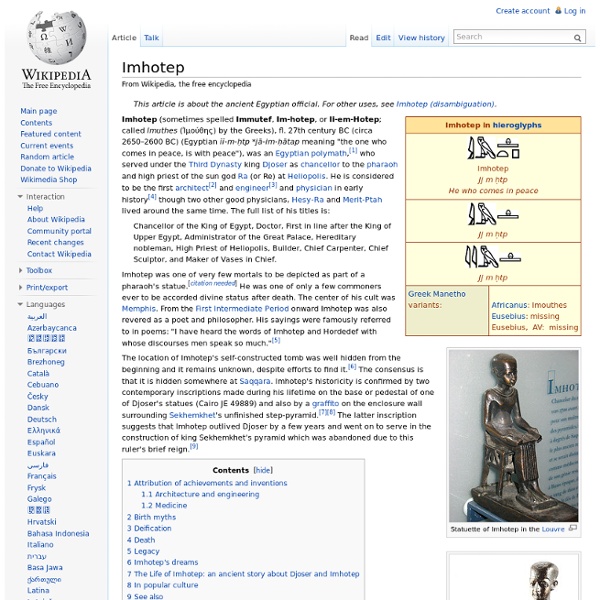Horus
Horus is one of the oldest and most significant deities in ancient Egyptian religion, who was worshipped from at least the late Predynastic period through to Greco-Roman times. Different forms of Horus are recorded in history and these are treated as distinct gods by Egypt specialists.[1] These various forms may possibly be different perceptions of the same multi-layered deity in which certain attributes or syncretic relationships are emphasized, not necessarily in opposition but complementary to one another, consistent with how the Ancient Egyptians viewed the multiple facets of reality.[2] He was most often depicted as a falcon, most likely a lanner or peregrine, or as a man with a falcon head.[3] Etymology[edit] Horus was also known as Nekheny, meaning "falcon". Note of changes over time[edit] In early Egypt, Horus was the brother of Isis, Osiris, Set and Nephthys. Horus and the pharaoh[edit] Origin mythology[edit] Mythological roles[edit] Sky god[edit] God of war and hunting[edit]
Wondjina
In Aboriginal mythology, the Wondjina (or Wandjina) were cloud and rain spirits who, during the Dream time, created or influenced the landscape and its inhabitants.[1] When they found the place they would die, they painted their images on cave walls and entered a nearby waterhole. The Wondjina style dates from around 3800 B.P., following the end of a millennium long drought that gave way to a wetter climate characterised by regular monsoons.[2] Today, certain Aboriginal people of the Mowanjum tribes repaint the images to ensure the continuity of the Wondjina's presence.[3] Annual repainting in December or January also ensures the arrival of the monsoon rains, according to Mowanjum belief.[4] Repainting has occurred so often that at one site the paint is over 40 layers deep. The painting style evolves during this process: the figures of recent years are stockier and some now possess eyelashes.[5] In 2007, graffiti depictions of Wandjina appeared in Perth, Western Australia.
Hor-Aha
Hor-Aha (or Aha or Horus Aha) is considered the second pharaoh of the first dynasty of ancient Egypt in current Egyptology. He lived around the thirty-first century BC and is thought to have had a long reign. Identity[edit] Name[edit] The commonly-used name Hor-Aha is a rendering of the pharaoh's Horus-name, an element of the royal titulary associated with the god Horus, and is more fully given as Horus-Aha meaning Horus the Fighter.[1] For the Early Dynastic Period, the archaeological record refers to the pharaohs by their Horus-names, while the historical record, as evidenced in the Turin and Abydos king lists, uses an alternative royal titulary, the nebty-name.[1][2] The different titular elements of a pharaoh's name were often used in isolation, for brevity's sake, although the choice varied according to circumstance and period.[2] Inscription bearing Hor-Aha's serekh together with a Nebty-name expressed with the game-board hieroglyph, which could be read mn. Theories[edit] Reign[edit]
Maat - Wikipedia, the free encyclopedia - Waterfox
The earliest surviving records indicating Maat is the norm for nature and society, in this world and the next, were recorded during the Old Kingdom, the earliest substantial surviving examples being found in the Pyramid Texts of Unas (ca. 2375 BCE and 2345 BCE).[2] Later, as a goddess in other traditions of the Egyptian pantheon, where most goddesses were paired with a male aspect, her masculine counterpart was Thoth and their attributes are the same. After the rise of Ra they were depicted together in the Solar Barque. After her role in creation and continuously preventing the universe from returning to chaos, her primary role in Egyptian mythology dealt with the weighing of souls that took place in the underworld, Duat.[3] Her feather was the measure that determined whether the souls (considered to reside in the heart) of the departed would reach the paradise of afterlife successfully. Maat as a principle[edit] Winged Maat Maat and the law[edit] Maat wearing feather of truth See also[edit]



